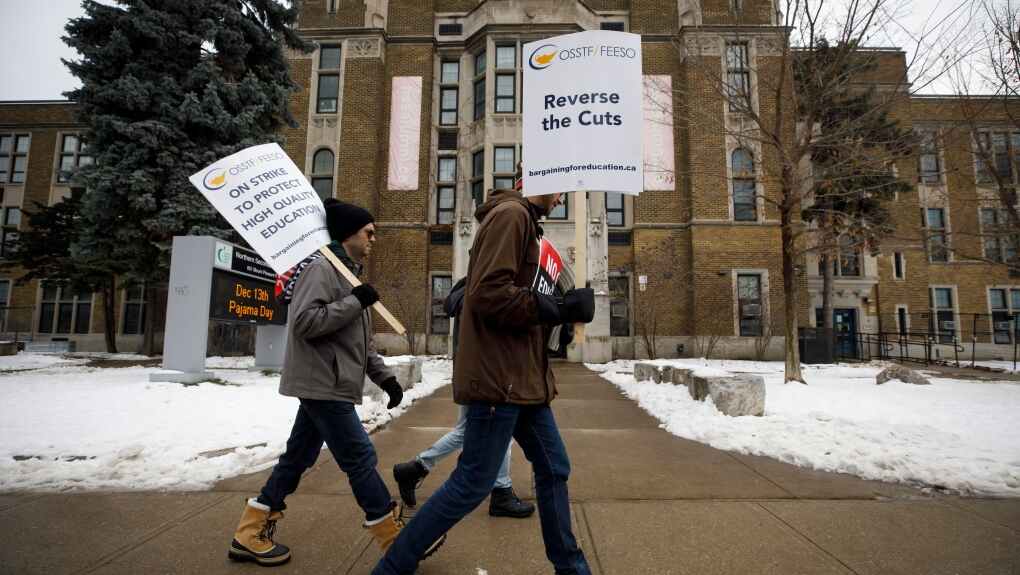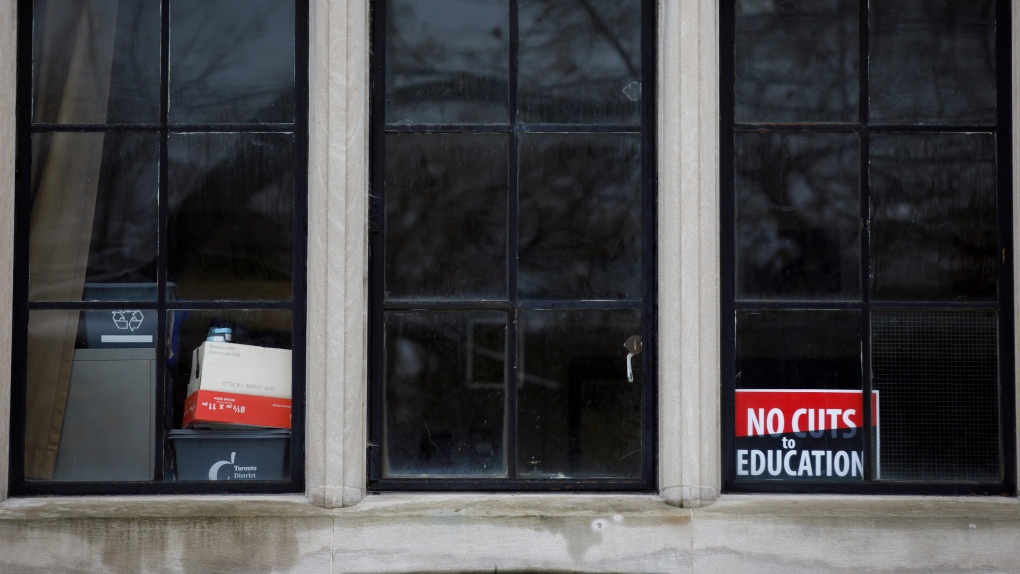What you need to know as Ontario education sector negotiations get underway
 Striking teachers of the Ontario Secondary School Teachers Federation picket outside of the Toronto District School Board head office on Yonge St. in Toronto on December 4, 2019. THE CANADIAN PRESS/Cole Burston
Striking teachers of the Ontario Secondary School Teachers Federation picket outside of the Toronto District School Board head office on Yonge St. in Toronto on December 4, 2019. THE CANADIAN PRESS/Cole Burston
Bargaining with Ontario’s five education sector unions got underway this week ahead of the expiration of collective agreements at the end of August.
It’s the beginning of a long process as the Ontario government tries to hammer out new deals with unions representing more than 243,000 education workers, many of which feel like they have fallen behind over the last number of years due to provincial legislation capping public sector wage increases at one per cent.
In a statement provided to CP24.com this week, Education Minister Stephen Lecce said that he is committed to “landing a deal that keeps students in class without any disruptions,” especially in light of learning loss during the COVID-19 pandemic.
But some of the unions representing education workers are expecting a challenging process after the Ford government laid out a plan in 2019 to increase class sizes, prompting months of labour unrest and a series of rotating strikes by secondary school teachers.
Here is what you need to know about the road ahead:
THERE IS A TWO-TIERED BARGAINING PROCESS IN THE EDUCATION SECTOR
The unions will use their initial bargaining sessions with the province, in part, to sort through which issues will be negotiated at the central table and which issues can be negotiated directly between schools boards and their local unions. Ontario English Catholic Teachers' Association (OECTA) President Barb Dobrowolski tells CP24 that the central issues are typically monetary, with compensation and class sizes usually the most contentious topics. She said that issues around “staffing processes,” like vacancies and job postings, are typically negotiated locally.
- Download our app to get local alerts to your device
- Get the latest local updates right to your inbox
ALL PARTIES SEEM WILLING TO MOVE BEYOND BILL 124
The Progressive Conservative government passed legislation in 2019 limiting public sector wage increases to one per cent annually but with Bill 124 set to expire later this year, Premier Doug Ford has said that teachers and education workers can expect a wage increase of “more than one per cent.” The question, of course, is how high the government will be willing to go amid surging inflation that has pushed the cost of living up for all Ontarians. Ontario Secondary Schools Teachers Federation (OSSTF) President Karen Littlewood told CP24 this week that her members were “encouraged” to hear Ford speak about the end of Bill 124 last month but at the same time she said that it is too early to know “what the offer is going to be or whether it will come at a cost” in terms of other concessions.
“It has been incredibly frustrating,” she said of Bill 124. “They (education workers) just don’t feel the respect they deserve after having put everything on the line through the pandemic to make sure students had the education they needed.”
 Striking teachers of the Ontario Secondary School Teachers Federation walk the picket line outside of Northern Secondary School in Toronto, Wednesday, Dec. 4, 2019. THE CANADIAN PRESS/Cole Burston
Striking teachers of the Ontario Secondary School Teachers Federation walk the picket line outside of Northern Secondary School in Toronto, Wednesday, Dec. 4, 2019. THE CANADIAN PRESS/Cole Burston
AT LEAST ONE OF THE UNIONS IS COMMITTED TO 'OPEN BARGAINING'
CUPE’s Ontario School Board Council of Unions (OSBCU), which represents 55,000 education workers, said this week that it will be publicly releasing all all details of the proposals it makes as well as the proposals it receives as part of a commitment to “open and transparent” bargaining.
The union says that it is new approach geared at generating a public conversation around the state of public education.
“We believe that not just our members but our community need to know what is happening. What happens at the bargaining table impacts our communities as far as what we are able to provide,” OSBCU President Laura Walton told CP24.com this week. “Ensuring that there is a custodian on site for communities of schools, ensuring there is adequate services in place for parents so that when they send their child to school they can understand that there will be the people in place to keep them safe, secure and successful. These are all important pieces and it is why we are moving forward with a more open process.”
TALKS ARE GETTING UNDERWAY A LITTLE EARLY
OSSTF President Karen Littlewood told CP24.com that it would be “more typical” for bargaining to start after the expiration of the current collective agreements at the end of the August, rather than in July. She said that the fact that talks got underway with most unions this week is a positive sign. A spokesperson for Education Minister Stephen Lecce said that initial bargaining sessions were, in fact, held with four of the five education sector unions this week . Representatives for the fifth and final union, which represents teachers and education workers in Ontario’s French school boards, are scheduled to sit down with the government on Monday.
“We stand ready to meet with any union, 24/7, without exception,” the spokesperson said, noting that invitations have already been sent out for future bargaining sessions.
THE FORD GOVERNMENT WANTS LONGER AGREEMENTS THAN IN THE PAST
Collective agreements in the education sector have typically been for a three year term but in a memo sent to unions earlier this month, Lecce said that the government was seeking feedback on a longer four-year timeline. The education minister said that the longer agreement would provide more “stability for staff, students, parents and guardian” and help schools move beyond the COVID-19 pandemic. The OSBCU has suggested the move is largely political as ensuring labour peace would bolster the PC’ government’s re-election chances in 2026. Other unions, meanwhile, have suggested that they would consider the longer term but only if it is part of a wider agreement that addresses a number of important issues.
“You don’t pre-determine that you are going to have an agreement of a certain length without knowing what else is going to be offered at the table,” Littlewood told CP24.com.
 A sign is seen inside a secondary school classroom window as teachers walk the picket line outside in Toronto, Wednesday, Dec. 4, 2019. THE CANADIAN PRESS/Cole Burston
A sign is seen inside a secondary school classroom window as teachers walk the picket line outside in Toronto, Wednesday, Dec. 4, 2019. THE CANADIAN PRESS/Cole Burston
THE EXPANSION OF REMOTE LEARNING COULD BE CONTENTIOUS
In 2019, the Ford government announced that secondary school students would have to take four online courses to graduate but ultimately scaled back that plan public backlash, instead saying that students would have to take two online courses and that exceptions could be made on an individual basis. It is unclear whether the government will look to further expand online learning as part of this round of negotiations but all of the union leaders that spoke with CP24.com suggested that they will be ready to fight should that be the case.
“What we saw during the pandemic was that teachers were really amazing, they spared no effort in trying to adjust their teaching online, they did their all to try to engage kids, but virtual education is a poor substitute for in-person learning,” OECTA President Barb Dobrowolski said.
“We have to recognize the needs of students and that face-to-face is the best way to learn,” the OSSTF’s Karen Littlewood added. “We have to avoid any push towards privatization and any push towards the degradation of the public school system. We have to make sure we are funding public education as an investment because that is what it is.”
DIFFERENT UNIONS HAVE DIFFERENT ISSUES, SOMETIMES EVEN WITHIN THEIR RANKS
The OSBCU represents thousands of frontline education workers, including custodians, school library workers, administrative assistants, Early Childhood Educators, information technologists, bus drivers, cafeteria employees and clerical staff. It says that its average member is making only $39,000 a year and is just struggling to get by, making compensation perhaps its biggest priority during this round of negotiations. .
“We are hearing more and more from folks who are not able to qualify for mortgagees or not able to qualify for rental applications because of their low income,” Walton told CP24.com.
The OSSTF, meanwhile, represents 60,000 members. About one-third of those members are education workers who tend to have lower salaries. The remaining two-thirds are teachers who make more than $100,000 a year on average.
“Working conditions are really major right now for us,” Littlewood told CP24. “People need to know that they are going to have somewhere safe to work but they also need to know that they are going to be able to manage the workload, whether they are an education worker or a teacher, and to face the possibility of cuts is really challenging.”
PARENTS CAN LIKELY COUNT ON SCHOOL STARTING ON SCHEDULE IN SEPTEMBER, AT THE VERY LEAST
In 2019 the talks between the union and the government dragged on for months, until the OSSTF began staging rotating one-day strikes in December of that year. The Elementary Teachers Federation of Ontario then did the same, starting in January.
“Education workers and teachers are going to continue to be there for the students,” Littlewood promises. “We have every intention to be in the classroom in the fall to welcome back students face-to-face.”
CTVNews.ca Top Stories

Donald Trump says Canada becoming 51st U.S. state is 'a great idea.' Jean Charest calls the comment a 'wake-up call'
U.S. President-elect Donald Trump is taking aim at Canada once more, saying it would be 'a great idea' to make it America's ‘51st state.'
'You're either with Beijing or you're with Washington': Ford says to Mexico in CNN interview
Ontario Premier Doug Ford has a message for Mexico as the threat of tariffs by incoming president Donald Trump hangs over both sides of the U.S. border.
There are 88 new Order of Canada appointees. Here's a look at some of the most notable names
Ryan Reynolds, Scott Oake and Maureen Ann Jennings are among the 88 new recipients of the Order of Canada.
NEW Here's how the cost of living challenges are shaking up Canadian seniors' retirement plans
With the high cost of living increasingly a concern, some seniors are making sacrifices to help their adult children and grandchildren make ends meet. Here are some of their stories.
Iconic Halifax ship Theodore Too partially sunk at Ontario dock
An iconic ship that was a fixture in Halifax Harbour for 21 years has partially sunk in Ontario.
Oscars shortlist revealed. See which movies made the cut
A shortlist of Oscar contenders in ten categories has been revealed.
Canada Post provides update on Santa letters
Canada Post provided an update Wednesday about letters addressed to Santa, reassuring children that their letters will be delivered to the North Pole by Christmas Eve. However, Santa won't have time to respond to them.
Thousands of toddler step stools recalled after child's head gets stuck
Thousands of toddler step stools are being recalled after a child's head got stuck in one.
Brazilian judge orders Adele song removed over plagiarism claim
A judge in Rio de Janeiro has ordered the global removal of a 2015 song by British singer Adele due to a plagiarism claim by a Brazilian musician, which Universal Music is fighting on appeal.

































